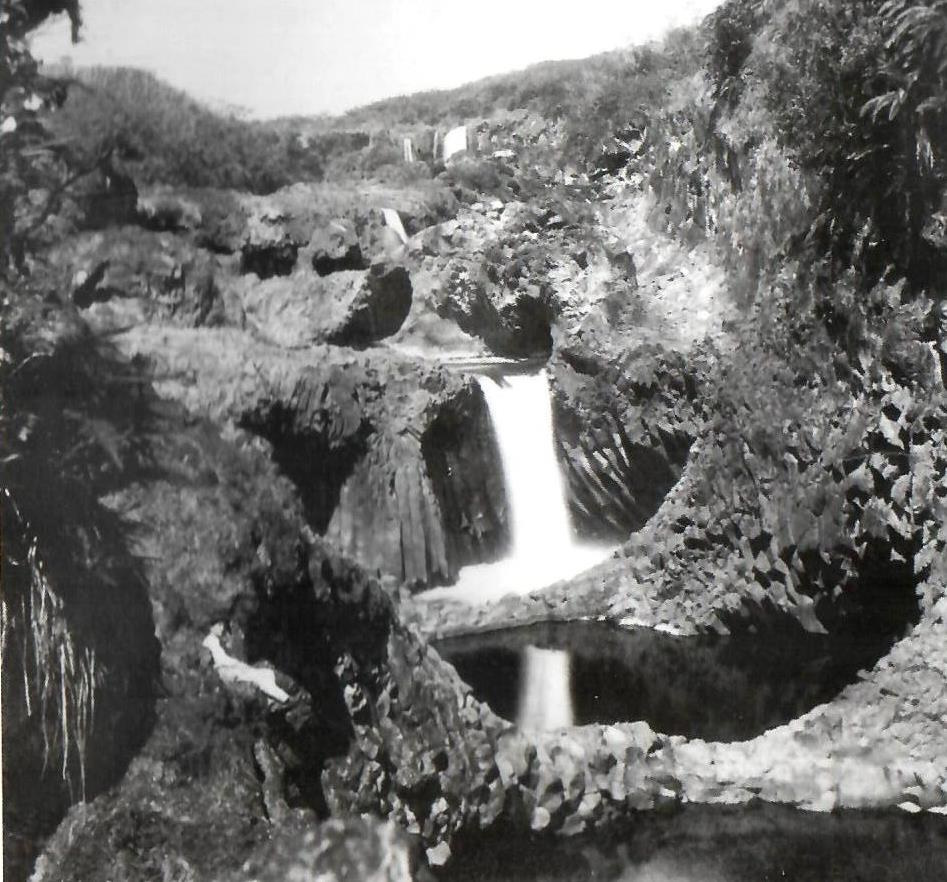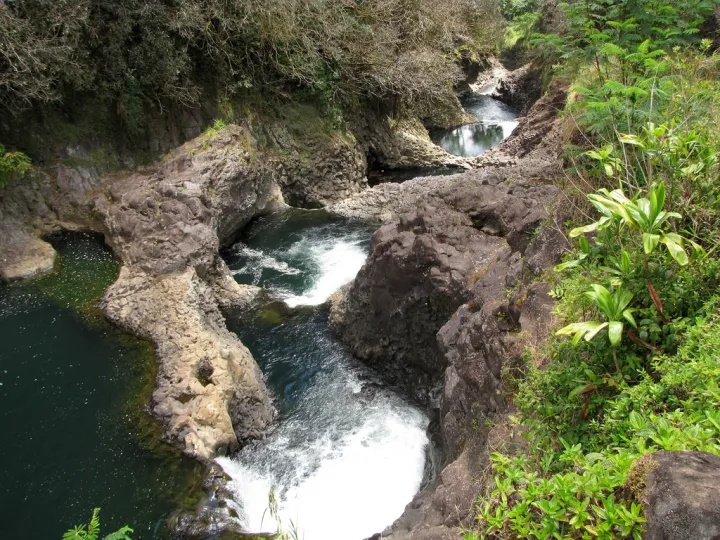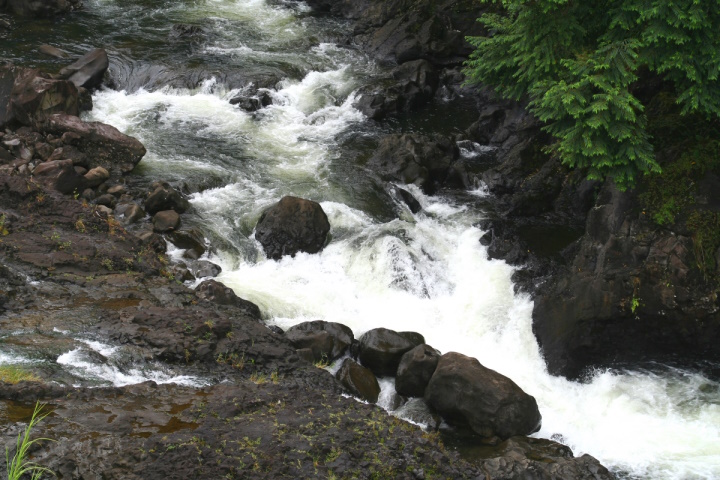Papaʻāpoho describes a flat area with a depression or hollow, which is how the island of Papaʻāpoho is shaped. It’s over 1,000-miles from Honolulu.
This 23.4-million-year-old island is over 1.2-miles across and has a land area of approximately 400-acres, making it the third largest island within the Papahānaumokuākea Marine National Monument (to the northwest of the Main Hawaiian Islands.)
Like its name, the island has an elevated rim (its highest point is a 40-foot-high sand dune) surrounding a broad central depression; its lowest point is a depression to the south that runs as a channel toward the ocean.
“This is a low, sandy island, elevated from 20 to 40 feet above the sea. It is about 1 1/4 miles long, and the northern part one mile wide; the surface is covered with green coarse grass.”
“There is what has been a lagoon near the southern part of the island, in the centre of which fresh water was found by digging 5-feet. Birds, fish, seal and turtle abound here, but not so plentiful as at Laysan Island.” (Paty, Polynesian, June 6, 1857)
At 10 pm, October 15, 1805, Urey Lisiansky (Yuri Fyodorovich Lisyansky,) an officer in the Imperial Russian Navy and commanding officer of the exploratory sloop-of-war Neva, ran aground on the island. Captain Lisiansky jettisoned some of the ship’s cargo to free themselves from the shallow waters.
“This island promises nothing to the adventurous voyager but certain danger in the first instance, and almost unavoidable destruction in the event. It stands in the middle of a very perilous coral bank, and, exclusive of a small eminence on the eastern part, lies almost on a level with the sea.” (A Voyage Round the World, Lisiansky, 1805)
“As there is no water, so neither are any trees to be seen on this island. We found, however, several large trunks of trees on the beach, which, no doubt, had been thrown up by the sea. … They were like the red-wood tree, that grows on the banks of the river Columbia in America. I am at a loss what conclusion to draw from the appearance of these trunks of trees in so remote a place.” (A Voyage Round the World, Lisiansky, 1805)
“I also found on the beach a small callabash, which had a round hole cut on one side of it. This could not have been drifted from a great distance, as it was fresh and in good preservation.” (A Voyage Round the World, Lisiansky, 1805)
Before leaving, Lisiansky named the island and shoal; “To the south-east point of the bank where the vessel grounded, I gave the name of Neva; while the island itself, in compliance with the unanimous wishes of my ship’s company, received the appellation of Lisiansky.” (A Voyage Round the World, Lisiansky, 1805)
The spelling Lisianski (not Lisyansky) was officially adopted by the US Geographic Board, October 1, 1924. Other names by which the island has been called include: Lisiansky, Lysianski, Lassion and Pell. (Thrum)
In 1857, King Kamehameha IV asked Captain John Paty to make a voyage of exploration to the Northwestern Hawaiian Islands. In part, he was sent to investigate the possibility of guano deposits on islands there (for fertilizer for the growing agricultural economy back on the Main Hawaiian Islands.
In addition, he confirmed or corrected the existence (or not) of many islands noted on old charts; “A considerable portion of the time absent has been consumed in looking after islands and banks which do not exist, or are erroneously marked on Blunt’s charts.” (Paty, Polynesian, June 6, 1857)
In the course of his voyage on the schooner “Manuokawai,” on May 11, 1857, Paty took possession of Lisianski Island for the Hawaiian Kingdom (he had previously annexed Laysan, its nearest neighbor, on May 1, 1857.)
In 1890, George D Freeth, an Englishman who had visited the area as early as 1864, and George N Wilcox, who had previously managed a guano operation on Jarvis Island, formed the North Pacific Phosphate and Fertilizer Company.
March 31, 1893, the Provisional Government of the Hawaiian Islands adopted Act 22, confirming the contract between the Minister of Interior and North Pacific for a license for the removal of guano and phosphates from Lisianski (and Laysan.)
Guano mining (1890s,) the release of rabbits (1903) and mice caused ecological damage to Lisianski, as well as the loss of a breeding population of land birds (the Laysan duck was first reported on Lisianski Island in 1828.)
Feather collecting began on Lisianski about 1904. In response to public outcry about the feather trade, Theodore Roosevelt established the Hawaiian Island Bird Reservation, which included Lisianski, in 1909.
An armed party landed on the island in 1910. They arrested feather poachers and confiscated and destroyed about 1.4 tons of feathers, representing 140,400 birds. (NOAA)
Today, with poaching at an end, the rabbits exterminated, and the vegetation again spreading over its low sandy surface, Lisianski once more is becoming a populous bird sanctuary. (janeresture)
It is home to a large Bonin petrel colony (over three-quarters of the Bonin Petrels that nest in Hawaii nest here) and sooty tern colony, as well as a variety of other seabirds.
Lisianski has the only grove of Pisonia grandis trees in the entire Hawaiian Archipelago; this tree is dispersed by seabirds and is favored as a nesting site for many tree-nesting seabird species.
The reefs of Lisianski and surrounding Neva Shoals are called “coral gardens” by some scientists because of their abundance of coral and the variety of growth forms assumed by their colonies, including structures resembling spires, castles, and a variety of other shapes.
Hawaiian monk seals and green sea turtles are common visitors to Lisianski’s sandy white beaches. Migratory shorebirds seen on the island include the kolea (golden plover,) ulili (wandering tattler,) and kioea (bristle-thighed curlew.) The volcanic island is undergoing the slow process of erosion. (NOAA)
Click HERE for a link to a ‘street view’ of Lisianski.








































